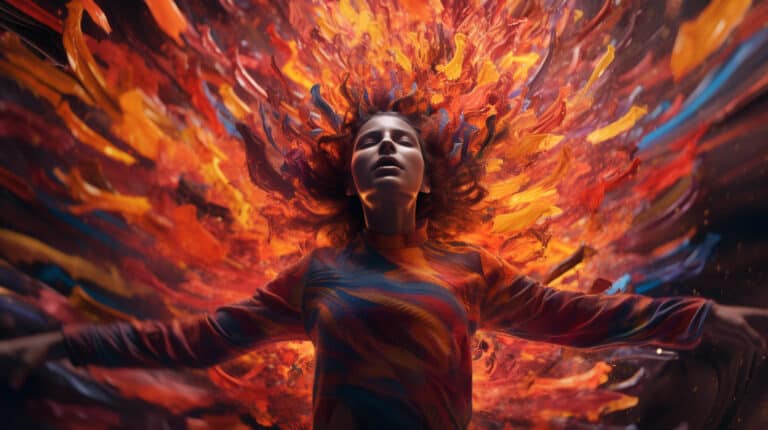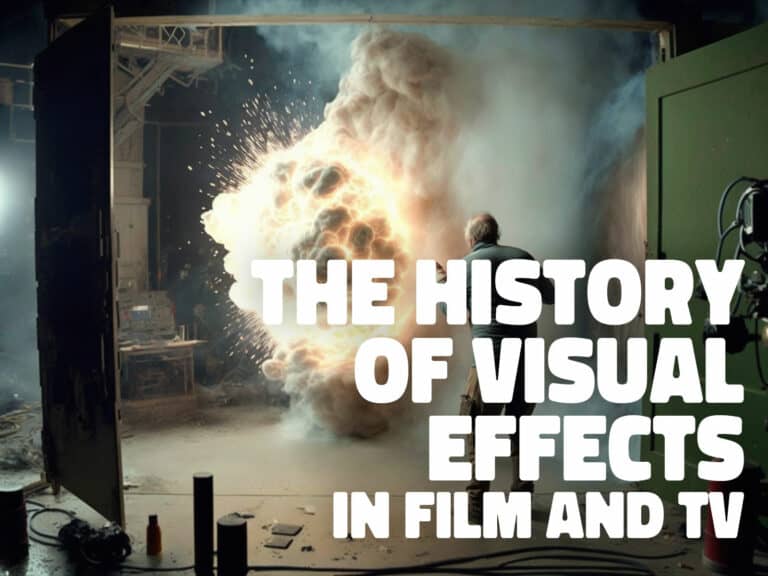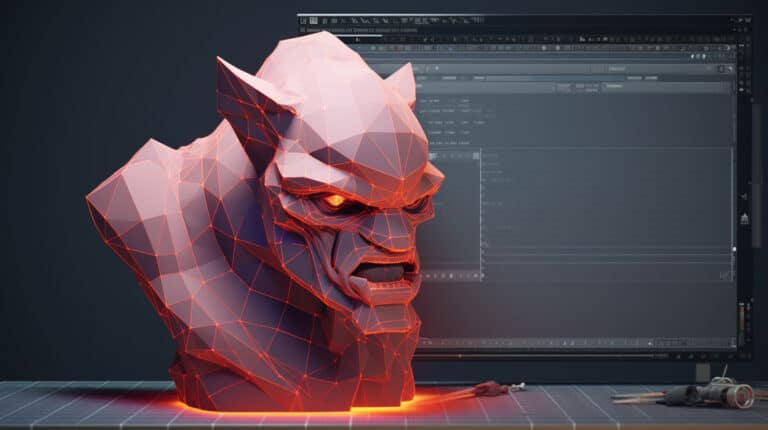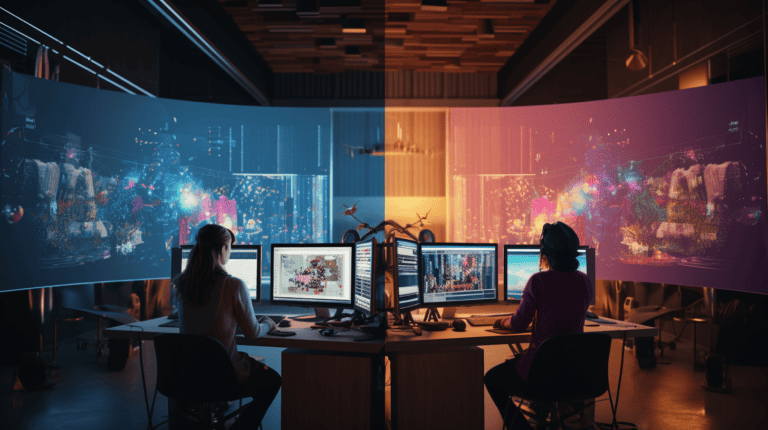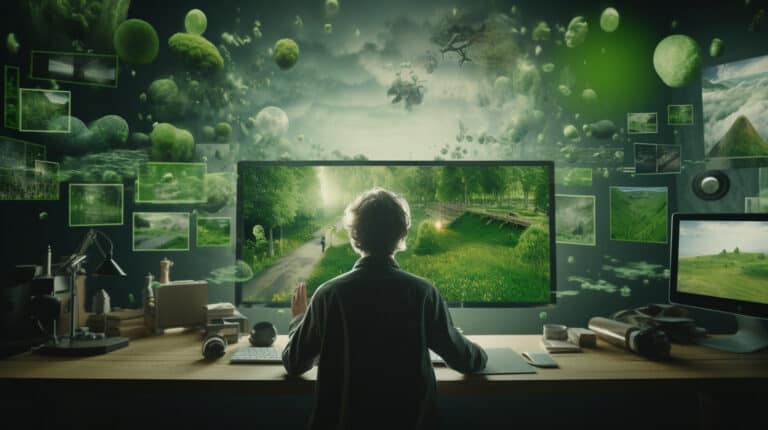The Future of Visual Effects: Trends and Predictions
Are you excited to see what the future of visual effects has in store?
Let’s explore some of the trends and predictions to find out how virtual production is revolutionizing the way we design sets.
Get ready to be amazed!
Key Points:
- Virtual production is revolutionizing the film industry by combining virtual elements with real-world production.
- LED walls are becoming popular, providing improved creative control, flexibility, and the ability to create visually stunning sets with ease.
- Virtual production offers a more natural and believable final product compared to chroma key green screen, with the added benefit of actors being able to interact with virtual sets in real-time.
- Artificial intelligence in visual effects and gaming enhances creativity, increases efficiency, and streamlines production processes.
The Future of VFX
You may have heard of visual effects (VFX) before, but do you know just how much of a role they play in the entertainment industry?
This article will explore the trends and predictions of the future of VFX, giving you insight into how these effects are changing the industry as we know it.
Definition of Visual Effects
You may be wondering what visual effects are and how they will shape our future. Visual effects, often abbreviated as VFX, are the processes used to create images using computer-generated imagery (CGI). VFX can be used to create realistic environments, characters, and objects and can also be used to add special effects to existing footage.
| Type of VFX | Examples |
|---|---|
| Virtual Production | Virtual Production Stage, Virtual Production LED Wall |
| CGI | Animated Characters, Environments, Objects |
| Special Effects | Explosions, Smoke, Fire |
VFX will continue to be a crucial part of the film industry, providing limitless possibilities for creativity and storytelling.
Importance of Visual Effects in the Entertainment Industry
Building on the definition of visual effects and its various types, it’s clear how important it is to the entertainment industry and its future.
- Visual effects contribute to the creation of extraordinary and captivating visuals.
- Virtual production vs green screen.
- The future of visual effects.
They enhance the storytelling experience and make the audience feel more connected to the characters.
Visual effects are a crucial part of the filmmaking process, allowing filmmakers to bring their imagination to life.
Virtual Production: Revolutionizing Visual Effects
Are you ready to revolutionize visual effects?
Virtual Production is set to do just that – by combining virtual elements with real-world production, it has the potential to completely shake up the industry.
Let’s explore the advantages and compare virtual production to traditional filmmaking.
What is Virtual Production
Your production process could be revolutionized with virtual production. It’s a new technology for filmmakers that combines the power of real-time rendering, motion capture, and virtual sets, allowing for unparalleled flexibility:
- Real-time Rendering:
- Create lifelike digital sets and environments
- Visualize changes without the need for reshoots
- Motion Capture:
- Record complex movements and actions with ease
- Enhance and refine shots quickly and accurately.
Virtual production can help filmmakers take their projects to the next level. It offers an abundance of advantages and can make the production process smoother and more efficient.
Advantages of Virtual Production
Discover the many advantages of virtual production and how it can revolutionize the visual effects process.
Virtual production saves time and money by streamlining the entire process.
It also allows creativity to be unleashed, enabling filmmakers to experiment with new ideas.
Real-time feedback helps VFX artists to make faster decisions and deliver higher-quality work.
Additionally, it allows for a more collaborative workflow, as filmmakers can collaborate with remote teams and access powerful tools.
With virtual production, filmmakers are able to more quickly and accurately bring their visions to life.
Virtual Production vs Traditional Filmmaking
With two distinct approaches to filmmaking available, it’s important to consider the pros and cons of virtual production compared to traditional filmmaking:
Virtual Production:
- Pros: Cost-effective, time-saving, creative flexibility
- Cons: Technical complexity
Traditional Filmmaking:
- Pros: Familiar workflow, fewer technical issues
- Cons: Costly, time-consuming, limited creativity
Innovative and inspiring, virtual production has revolutionized visual effects and is poised to shape the future of filmmaking.
The Rise of Virtual Production Stages
You’ve heard of virtual production, but do you know what it means?
Virtual production stages provide a solution to many production challenges, but they also come with their own set of limitations.
Let’s explore the rise of virtual production stages and the impact they’ve had on visual effects.
Introduction to Virtual Production Stages
Although virtual production stages are still a relatively new concept, they’re becoming increasingly popular as the future of visual effects. Here’s why:
- Benefits:
- Cost savings
- Streamlined workflow
- Challenges:
- Technical complexity
- Limited resources
Virtual production stages are a powerful tool for creating stunning visuals with efficiency, providing the potential for dramatic savings in time and money. With the right team and resources, the potential for success is great.
Benefits of Virtual Production Stages
You can reap plenty of benefits from virtual production stages, making them a powerful tool for creating stunning visuals with efficiency.
From improved workflow and cost savings to more creative control and flexibility, virtual production stages offer a wide range of advantages.
With real-time feedback and pre-visualization, directors and artists can experiment and refine visuals with ease.
Moreover, virtual production stages provide the opportunity to capture multiple shots simultaneously, offering a faster, more efficient way to create visual effects.
Challenges and Limitations of Virtual Production Stages
Despite the numerous benefits virtual production stages offer, they come with some challenges and limitations that you should be aware of:
- Technical:
- Inaccurate color reproduction
- Limited lighting control
- Unreliable tracking systems
- Creative:
- Difficulty in creating a sense of atmosphere
- Limited sets and props
These difficulties must be taken into account when considering virtual production stages.
Moving forward, the focus should shift to virtual production LED walls: the future of set design.
Virtual Production LED Walls: The Future of Set Design
Are you curious about the future of set design?
Then, you should be exploring virtual production LED walls, which offer a host of advantages to filmmakers and production companies.
Discover the impact these walls could have on set design and production costs with this exploration of the latest visual effects trends and predictions.
What are Virtual Production LED Walls
Though there are many visual effects trends, virtual production LED walls are quickly becoming the future of set design. They offer filmmakers and production teams unprecedented control, flexibility, and creativity.
Control:
- Accurate real-time visualization of lighting and set design
- Ability to adjust on the fly
Flexibility:
- Easy to reuse for different scenes and locations
- Adaptable to different filming scenarios
Creativity:
- Limitless possibilities for visually stunning sets
- Ability to bring any story to life.
Virtual production LED walls are revolutionizing the art of storytelling.
Advantages of Virtual Production Led Walls
Aside from providing unprecedented control, flexibility, and creativity, virtual production LED walls offer a range of additional advantages. Designers can quickly change scenes, props, and lighting; scenes can be seen in real-time, and complex VFX can be applied with ease. | Cost savings: Virtual walls are more eco-friendly, cost-effective, and require less physical space. | Quality: High-definition resolution and dynamic lighting allow for top-notch visuals and effects. | Impact: These advantages lead to increased efficiency and reduced time and cost in set design and production.
Impact on Set Design and Production Costs
Looking ahead, virtual production LED walls can have a major impact on set design and production costs:
Set Design:
- Increased accuracy of virtual sets
- Reduced costs of physical sets
Production Costs:
- Easier and faster production setup
- Reduced time and labor costs
This makes virtual production LED walls a cost-effective solution for film and television production, paving the way for an exciting future in visual effects.
Transitioning now to ‘virtual production vs. green screen: a comparison’.
Virtual Production vs Green Screen: A Comparison
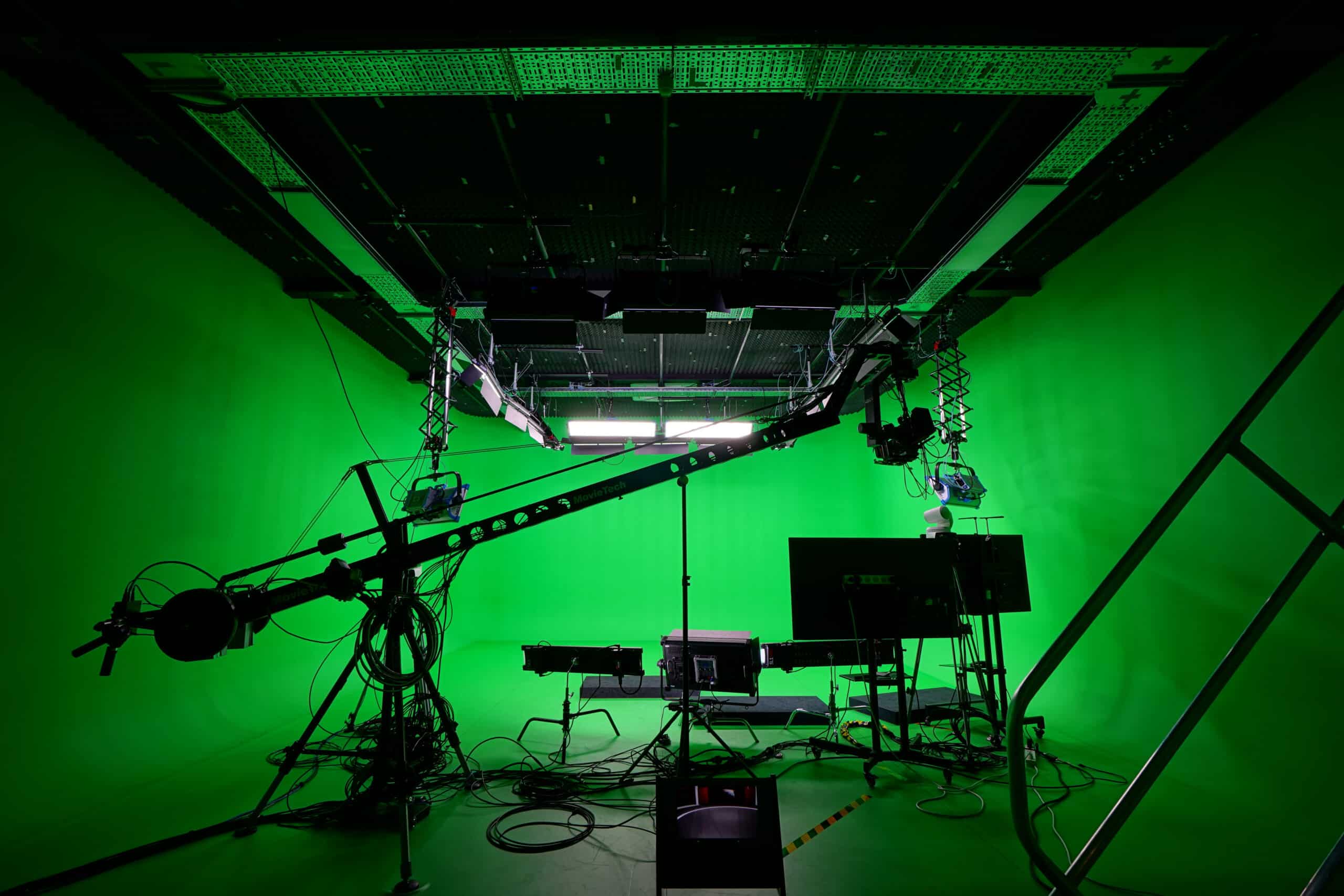
Virtual production is a game-changer for visual effects. It offers a new way of creating realistic and immersive environments for films, TV shows, and other media. Traditional green screen techniques have long been the go-to method for creating special effects. While green screen has its advantages, such as flexibility and cost-effectiveness, it also has its disadvantages. For example, actors often struggle to perform in front of a blank green screen, and there can be issues with lighting and shadows. Virtual production, on the other hand, combines the best of both worlds. It allows filmmakers to create virtual sets and environments that actors can interact with in real-time. This not only makes it easier for actors to perform, but also helps to create a more natural and believable final product. Virtual production is revolutionizing the industry by providing a more efficient and effective way of creating visual effects.
Traditional Green Screen Techniques
Exploring traditional green screen techniques in the future of visual effects reveals different advantages and disadvantages compared with virtual production.
Benefits include:
- Cost:
- Low upfront cost
- Flexible budget
- Quick results
Drawbacks include:
- Limited control:
- Difficult to accurately control lighting
- Limited ability to edit footage
- Time consuming:
- Long set up
- Slow to troubleshoot
Advantages and Disadvantages of Green Screen
You may find that green screen has both pros and cons when it comes to creating visual effects.
It can provide filmmakers with a wide range of options, enabling them to create incredibly realistic effects.
On the other hand, green screen can be time-consuming and difficult to use. It requires a great deal of skill and experience to ensure that the effects look realistic.
While green screen can be a powerful tool, it’s becoming increasingly clear that virtual production is changing the game.
How Virtual Production is Changing the Game
With the advent of virtual production, filmmakers can now achieve realistic visual effects in a fraction of the time and cost of traditional green screen techniques. Here’s how:
Cost savings:
- No need for large, expensive sets and crew
- Reduction in post-production costs
Time savings:
- No need to re-shoot scenes
- Ability to add effects in real-time
The virtual production revolution has enabled filmmakers to create more immersive and captivating visuals than ever before. It’s no wonder it’s quickly becoming the new standard in filmmaking.
The Role of Artificial Intelligence in Visual Effects
Are you ready to explore the exciting possibilities of Artificial Intelligence (AI) in the world of visual effects?
From its impact on the creation of effects to streamlining the production process, AI has the potential to revolutionize the industry.
However, there are ethical considerations and challenges to consider as well.
AI’s Impact on Visual Effects Creation
Although AI technology has long been used to create visual effects, recent advances have made it increasingly capable of producing more complex and lifelike visuals. AI’s impact on VFX creation:
- Benefits:
- Enhances creativity
- Increases efficiency
- Reduces cost
- Challenges:
- Difficult to manage
- Not always reliable
- Security risks.
AI’s potential for revolutionizing the industry is clear, but careful implementation is essential.
AI’s Role in Streamlining Production Processes
Building on the potential of AI to revolutionize the visual effects industry, it’s now increasingly being used to streamline production processes and enhance efficiency. AI technologies are being used to automate mundane tasks and free up valuable resources for more creative endeavors.
This allows for faster turnaround times and improved productivity for the entire production team. AI-driven solutions can also aid in problem-solving quickly and efficiently, saving time and money.
With AI, the future of visual effects looks brighter than ever before.
Ethical Considerations and Challenges of AI in Visual Effects
Building on the potential of AI to revolutionize the visual effects industry, it’s now increasingly important to consider the ethical implications and challenges associated with its use:
- Ethical concerns:
- Privacy issues
- Misuse of data
- Lack of regulation
- Challenges:
- Automation of creative processes
- Lack of human oversight
These issues must be addressed if AI is to be a viable tool in the industry.
To complete the picture, the integration of virtual reality in visual effects must be explored.
The Integration of Virtual Reality in Visual Effects
You’ve probably heard of virtual reality (VR), but did you know that it’s already having a profound impact on the future of visual effects?
In this article, we’ll explore how VR is shaping the creation of visual effects.
We’ll also discuss how VR is enhancing immersive experiences.
VR’s Influence on Visual Effects Creation
You can now experience virtual reality’s influence on visual effects creation. It’s changing the way filmmakers create and deliver content, allowing for more nuanced and lifelike visuals.
With VR, filmmakers can:
- Experiment with new techniques
- Create more immersive experiences
Audiences can:
- Gain a deeper understanding of characters
- Feel more connected to stories
VR is revolutionizing visual effects and ushering in a new era of creativity and engagement.
VR’s Role in Enhancing Immersive Experiences
Building on the revolutionizing effects of virtual reality on visual effects creation, you can now experience enhanced immersive experiences through its integration. VR helps boost the realism of scenes with accurate lighting and shadows, realistic textures, and detailed surfaces. It also enables users to modify and manipulate virtual objects in a more interactive and intuitive manner. These features create a more lifelike and immersive experience, allowing viewers to become deeply engaged in the visual effects.
Transitioning into the next section, the challenges and future potential of VR in visual effects will be discussed.
Challenges and Future Potential of VR in Visual Effects
With many challenges and potential opportunities, virtual reality has a great impact on the future of visual effects.
Challenges:
- Expensive technology
- Limited content
Potential:
- New levels of immersion
- Unparalleled realism
The potential of virtual reality in visual effects paints a thrilling picture of the future.
Onward to the future of visual effects in gaming!
The Future of Visual Effects in Gaming
Are you curious to know how visual effects in gaming are changing?
Have you ever wondered what new advancements and innovations have been made in gaming visuals?
Let’s take a look at the current state of visual effects in the gaming industry and explore some predictions for the future.
Visual Effects in Current Gaming Industry
You’ll see more and more realistic visual effects in video games in the near future. From 3D animations and lifelike textures to realistic lighting and immersive environments, the current gaming industry is embracing the latest advances in visual effects.
- Cutting-edge technology:
- Photorealistic graphics
- Motion capture
- AI-driven animations
- Creative innovation:
- Stylized art
- Augmented reality
- Virtual reality
The convergence of these two forces is pushing the boundaries of what’s possible, giving players an ever-changing and immersive experience.
Advancements and Innovations in Gaming Visual Effects
Building on the realistic visuals and immersive experiences already available in the gaming industry, the future of visual effects is sure to bring exciting advancements and innovative new ideas.
Augmented and virtual reality, photorealistic graphics, dynamic weather and lighting, and interactive storytelling will become commonplace.
Developers will create complex and detailed worlds with physics-based simulations and AI-driven characters.
Animators will explore new techniques to make animations more lifelike.
All of this will culminate in a gaming experience that will be more realistic, immersive, and engaging than ever before.
Predictions for the Future of Visual Effects in Gaming
Looking ahead, you can expect gaming visual effects to become even more realistic, immersive, and engaging:
- For gamers:
- Better graphics
- More advanced AI
- Greater control
- For developers:
- Innovative tools
- Easier integration
- More efficient pipeline.
Innovative, inspiring, and captivating gaming visuals of the future will bring about a whole new level of realism, immersion, and fun.
The Impact of Real-Time Rendering on Visual Effects
Real-time rendering has become an increasingly popular technology within the visual effects industry. It has revolutionized the way VFX are created. Let’s explore the benefits and limitations of this technology.
Real-time rendering has fundamentally changed the way visual effects are produced.
Introduction to Real-Time Rendering
You’re likely familiar with the term ‘real-time rendering’ and its growing impact on the visual effects industry. It’s a powerful technology that enables faster and more efficient creation of high-quality visuals:
- What it is:
- Real-time rendering is a computer-generated 3D simulation of a scene that’s rendered in real-time.
- It offers an immersive experience, allowing for faster and more dynamic visuals.
- What it means:
- It speeds up the production process, making it easier to create complex visual effects.
- It allows for more creative freedom to create stunning visuals.
Real-time rendering is revolutionizing the visual effects industry and paving the way for the future.
Benefits and Limitations of Real-Time Rendering
With its numerous advantages and drawbacks, real-time rendering is changing the way visual effects are created. Its speed and efficiency streamline processes, giving artists more time to hone their craft and experiment with new techniques.
However, the limited complexity of rendered output can be limiting, making it better suited for more basic effects.
Real-Time Rendering’s Influence on Visual Effects Production
Building on the advantages and limitations of real-time rendering, you can expect to see its impact continue to shape the future of visual effects production.
Real-time rendering will continue to:
- Enable faster production cycles
- Quicker asset creation
- Faster delivery times
- Enable higher-quality visuals
- More realistic textures
- Improved lighting and shading
Conclusion
Now that we’ve explored the various trends and predictions that are shaping the future of visual effects, it’s time to take a step back and reflect on what this all means.
Let’s sum up what we’ve learned and consider the long-term implications of these developments.
Recap of Key Trends and Predictions
In wrapping up our discussion of the future of visual effects, let’s recap the key trends and predictions we’ve discussed:
- Increased realism:
- More realistic lighting, shadows, textures, and animation
- More photorealistic human characters
- Increased accessibility:
- More user-friendly tools and technology
- Easier integration with existing media
Be inspired by the possibilities of modern VFX and create the future!
Final Thoughts on the Future of Visual Effects
As you explore the potential of modern visual effects, you can be sure that the future looks bright. With the advances in technology and the creativity of filmmakers, we can expect to see incredible things.
From realistic CGI and immersive 3D effects to interactive, augmented reality experiences, the future of visual effects will be bold and expansive. We’ll see new capabilities and greater storytelling potential that will bring us closer to the world of our favorite movies.
With the right tools and vision, filmmakers will be able to create truly remarkable works of art.
Frequently Asked Questions
What Technology Is Needed to Create Visual Effects?
To create visual effects, you’ll need powerful computers, specialized software, and a creative eye. Use these tools to bring your ideas to life!
What Are the Potential Applications of Visual Effects in the Future?
You can use visual effects to create more engaging and immersive experiences in the future. Imagine bringing stories and characters to life, creating photorealistic environments, or creating interactive experiences in gaming and virtual reality. The possibilities are virtually endless!
What Are the Main Challenges Associated With Creating Visual Effects?
Creating visual effects can be challenging due to the need for specialized software, hardware, and artistic skill. It can be difficult to stay up-to-date with the latest trends and technologies. Time and budget constraints are also a factor.
What Is the Estimated Cost for Creating Visual Effects?
Creating visual effects typically costs thousands of dollars, depending on the complexity and the extent of the project. You can expect to pay for software, hardware, and other resources.
What Is the Timeline for Developing Visual Effects?
Creating visual effects takes time and requires planning. It can range from a few days to a few months, depending on the complexity. Let’s work together to develop a timeline that suits your needs.
Conclusion
As the technology for visual effects continues to advance, the possibilities for creating stunning works of art are truly endless. Visual effects will continue to be an integral part of the film and television industry, and the future looks brighter than ever.
With continued innovation and creativity, the future of visual effects is sure to be both exciting and inspiring. Let’s keep embracing the future and pushing the boundaries of what’s possible.


